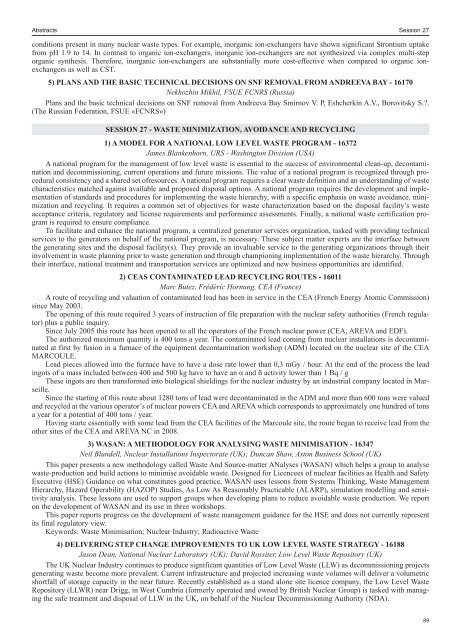The 12th International Conference on Environmental ... - Events
The 12th International Conference on Environmental ... - Events
The 12th International Conference on Environmental ... - Events
Create successful ePaper yourself
Turn your PDF publications into a flip-book with our unique Google optimized e-Paper software.
Abstracts Sessi<strong>on</strong> 27<br />
c<strong>on</strong>diti<strong>on</strong>s present in many nuclear waste types. For example, inorganic i<strong>on</strong>-exchangers have shown significant Str<strong>on</strong>tium uptake<br />
from pH 1.9 to 14. In c<strong>on</strong>trast to organic i<strong>on</strong>-exchangers, inorganic i<strong>on</strong>-exchangers are not synthesized via complex multi-step<br />
organic synthesis. <str<strong>on</strong>g>The</str<strong>on</strong>g>refore, inorganic i<strong>on</strong>-exchangers are substantially more cost-effective when compared to organic i<strong>on</strong>exchangers<br />
as well as CST.<br />
5) PLANS AND THE BASIC TECHNICAL DECISIONS ON SNF REMOVAL FROM ANDREEVA BAY - 16170<br />
Nekhozhin Mikhil, FSUE FCNRS (Russia)<br />
Plans and the basic technical decisi<strong>on</strong>s <strong>on</strong> SNF removal from Andreeva Bay Smirnov V. P, Eshcherkin A.V., Borovitsky S.?.<br />
(<str<strong>on</strong>g>The</str<strong>on</strong>g> Russian Federati<strong>on</strong>, FSUE «FCNRS»)<br />
SESSION 27 - WASTE MINIMIZATION, AVOIDANCE AND RECYCLING<br />
1) A MODEL FOR A NATIONAL LOW LEVEL WASTE PROGRAM - 16372<br />
James Blankenhorn, URS - Washingt<strong>on</strong> Divisi<strong>on</strong> (USA)<br />
A nati<strong>on</strong>al program for the management of low level waste is essential to the success of envir<strong>on</strong>mental clean-up, dec<strong>on</strong>taminati<strong>on</strong><br />
and decommissi<strong>on</strong>ing, current operati<strong>on</strong>s and future missi<strong>on</strong>s. <str<strong>on</strong>g>The</str<strong>on</strong>g> value of a nati<strong>on</strong>al program is recognized through procedural<br />
c<strong>on</strong>sistency and a shared set ofresources. A nati<strong>on</strong>al program requires a clear waste definiti<strong>on</strong> and an understanding of waste<br />
characteristics matched against available and proposed disposal opti<strong>on</strong>s. A nati<strong>on</strong>al program requires the development and implementati<strong>on</strong><br />
of standards and procedures for implementing the waste hierarchy, with a specific emphasis <strong>on</strong> waste avoidance, minimizati<strong>on</strong><br />
and recycling. It requires a comm<strong>on</strong> set of objectives for waste characterizati<strong>on</strong> based <strong>on</strong> the disposal facility’s waste<br />
acceptance criteria, regulatory and license requirements and performance assessments. Finally, a nati<strong>on</strong>al waste certificati<strong>on</strong> program<br />
is required to ensure compliance.<br />
To facilitate and enhance the nati<strong>on</strong>al program, a centralized generator services organizati<strong>on</strong>, tasked with providing technical<br />
services to the generators <strong>on</strong> behalf of the nati<strong>on</strong>al program, is necessary. <str<strong>on</strong>g>The</str<strong>on</strong>g>se subject matter experts are the interface between<br />
the generating sites and the disposal facility(s). <str<strong>on</strong>g>The</str<strong>on</strong>g>y provide an invaluable service to the generating organizati<strong>on</strong>s through their<br />
involvement in waste planning prior to waste generati<strong>on</strong> and through champi<strong>on</strong>ing implementati<strong>on</strong> of the waste hierarchy. Through<br />
their interface, nati<strong>on</strong>al treatment and transportati<strong>on</strong> services are optimized and new business opportunities are identified.<br />
2) CEAS CONTAMINATED LEAD RECYCLING ROUTES - 16011<br />
Marc Butez, Frédéric Hornung, CEA (France)<br />
A route of recycling and valuati<strong>on</strong> of c<strong>on</strong>taminated lead has been in service in the CEA (French Energy Atomic Commissi<strong>on</strong>)<br />
since May 2003.<br />
<str<strong>on</strong>g>The</str<strong>on</strong>g> opening of this route required 3 years of instructi<strong>on</strong> of file preparati<strong>on</strong> with the nuclear safety authorities (French regulator)<br />
plus a public inquiry.<br />
Since July 2005 this route has been opened to all the operators of the French nuclear power (CEA, AREVA and EDF).<br />
<str<strong>on</strong>g>The</str<strong>on</strong>g> authorized maximum quantity is 400 t<strong>on</strong>s a year. <str<strong>on</strong>g>The</str<strong>on</strong>g> c<strong>on</strong>taminated lead coming from nuclear installati<strong>on</strong>s is dec<strong>on</strong>taminated<br />
at first by fusi<strong>on</strong> in a furnace of the equipment dec<strong>on</strong>taminati<strong>on</strong> workshop (ADM) located <strong>on</strong> the nuclear site of the CEA<br />
MARCOULE.<br />
Lead pieces allowed into the furnace have to have a dose rate lower than 0,3 mGy / hour. At the end of the process the lead<br />
ingots of a mass included between 400 and 500 kg have to have an α and ß activity lower than 1 Bq / g<br />
<str<strong>on</strong>g>The</str<strong>on</strong>g>se ingots are then transformed into biological shieldings for the nuclear industry by an industrial company located in Marseille.<br />
Since the starting of this route about 1280 t<strong>on</strong>s of lead were dec<strong>on</strong>taminated in the ADM and more than 600 t<strong>on</strong>s were valued<br />
and recycled at the various operator’s of nuclear powers CEA and AREVA which corresp<strong>on</strong>ds to approximately <strong>on</strong>e hundred of t<strong>on</strong>s<br />
a year for a potential of 400 t<strong>on</strong>s / year.<br />
Having starte essentially with some lead from the CEA facilities of the Marcoule site, the route began to receive lead from the<br />
other sites of the CEA and AREVA NC in 2008.<br />
3) WASAN: A METHODOLOGY FOR ANALYSING WASTE MINIMISATION - 16347<br />
Neil Blundell, Nuclear Installati<strong>on</strong>s Inspectorate (UK); Duncan Shaw, Ast<strong>on</strong> Business School (UK)<br />
This paper presents a new methodology called Waste And Source-matter ANalyses (WASAN) which helps a group to analyse<br />
waste-producti<strong>on</strong> and build acti<strong>on</strong>s to minimise avoidable waste. Designed for Licencees of nuclear facilities as Health and Safety<br />
Executive (HSE) Guidance <strong>on</strong> what c<strong>on</strong>stitutes good practice, WASAN uses less<strong>on</strong>s from Systems Thinking, Waste Management<br />
Hierarchy, Hazard Operability (HAZOP) Studies, As Low As Reas<strong>on</strong>ably Practicable (ALARP), simulati<strong>on</strong> modelling and sensitivity<br />
analysis. <str<strong>on</strong>g>The</str<strong>on</strong>g>se less<strong>on</strong>s are used to support groups when developing plans to reduce avoidable waste producti<strong>on</strong>. We report<br />
<strong>on</strong> the development of WASAN and its use in three workshops.<br />
This paper reports progress <strong>on</strong> the development of waste management guidance for the HSE and does not currently represent<br />
its final regulatory view.<br />
Keywords: Waste Minimisati<strong>on</strong>; Nuclear Industry; Radioactive Waste<br />
4) DELIVERING STEP CHANGE IMPROVEMENTS TO UK LOW LEVEL WASTE STRATEGY - 16188<br />
Jas<strong>on</strong> Dean, Nati<strong>on</strong>al Nuclear Laboratory (UK); David Rossiter, Low Level Waste Repository (UK)<br />
<str<strong>on</strong>g>The</str<strong>on</strong>g> UK Nuclear Industry c<strong>on</strong>tinues to produce significant quantities of Low Level Waste (LLW) as decommissi<strong>on</strong>ing projects<br />
generating waste become more prevalent. Current infrastructure and projected increasing waste volumes will deliver a volumetric<br />
shortfall of storage capacity in the near future. Recently established as a stand al<strong>on</strong>e site licence company, the Low Level Waste<br />
Repository (LLWR) near Drigg, in West Cumbria (formerly operated and owned by British Nuclear Group) is tasked with managing<br />
the safe treatment and disposal of LLW in the UK, <strong>on</strong> behalf of the Nuclear Decommissi<strong>on</strong>ing Authority (NDA).<br />
89
















